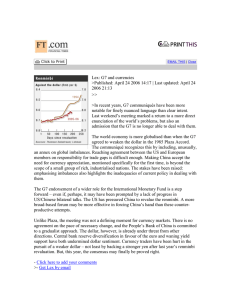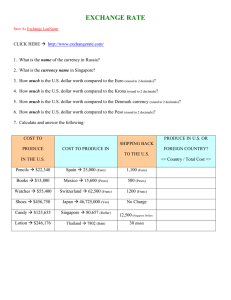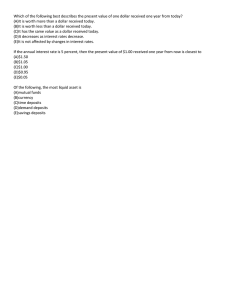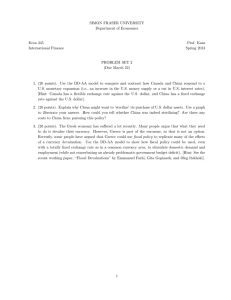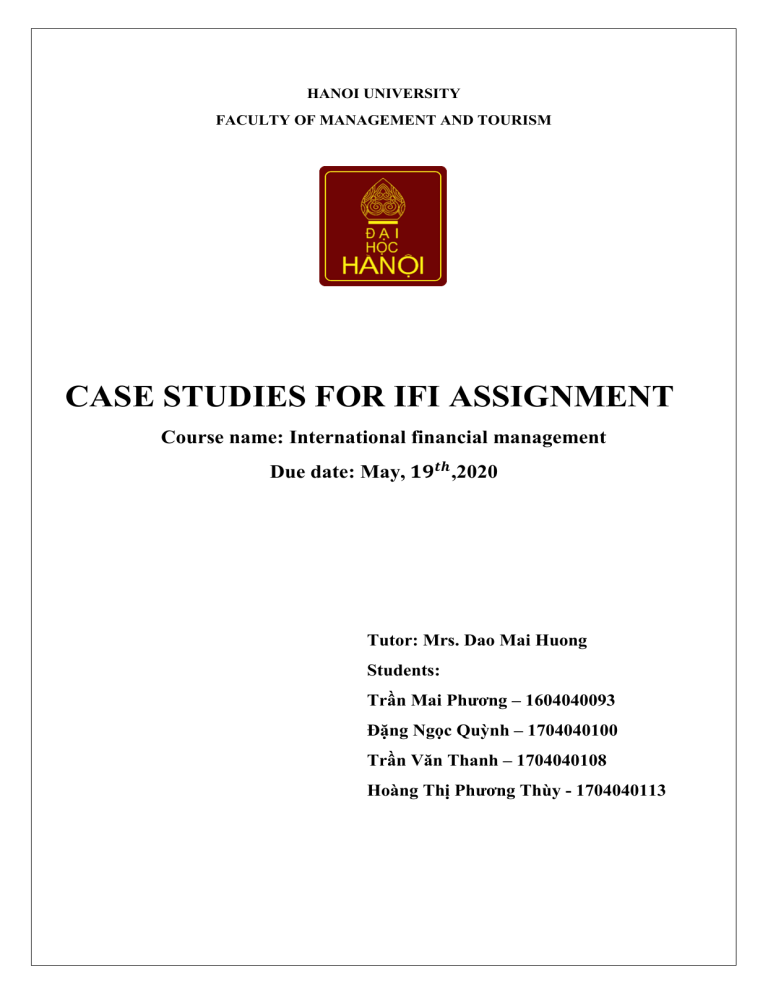
HANOI UNIVERSITY FACULTY OF MANAGEMENT AND TOURISM CASE STUDIES FOR IFI ASSIGNMENT Course name: International financial management Due date: May, ,2020 Tutor: Mrs. Dao Mai Huong Students: Trần Mai Phương – 1604040093 Đặng Ngọc Quỳnh – 1704040100 Trần Văn Thanh – 1704040108 Hoàng Thị Phương Thùy - 1704040113 CASE STUDY 1: THE SAGA OF THE VENEZUELAN BOLIVAR FUERTE CASE SUMMARY The case starts by recapping this was more of a change than the last devaluation. For general economic and exchange purposes the previous devaluation, January 1, 2008, had fixed the bolivar fort (BsF) at BsF4.30/$. Then present $3,000USD CADIVI controls when going abroad, and describe $400USD for internet-based buying. Rapidly updating the reports of the Chávez government and the central bank to claim its independence from the outside world; primarily the United States, which, in addition to being on the opposite sides of political opinion, blame for the state of its economy. In May 2010, Hugo Chavez sang measures to curb any kind of trading in the form of equity securities on the Venezuelan stock exchange, including foreign currency bonds. Made it clear what the aim was: to ensure that currency between USD 10,000-20000 could not be transferred without the Central Bank's knowledge and, should it be discovered that the parties have done so that they will be fined, doubled the amount of the Bolivarian activity. The case then describes the various times that the Chavez regime had devalued the currency: in 2003, $1600BS/$USD, in 2004, Bs $1920/$1USD, in 2005, Bs $2150/$1USD, and then in 2008, the Bolivar was replaced by Bolívar Fuerte, taking off three zeroes seeing BsF $2.15/$1USD and further devalued to BsF $4.38/$1USD in 2010. It then introduces SITME the Foreign Currency Denomination Securities Exchange System, which, unlike CADIVI, was another government agency developed to set the rate that businesses used to gain access to hard currency such as the US dollar to pay for inputs and imported components, but this rate was set at BsF $5.30/$1USD. QUESTIONS & ANSWERS 1. Why must a country’s currency be devalued? What is failing in the economy? A strong currency is not necessarily in a nation's best interests. A weak domestic currency makes a nation's exports more competitive in global markets, and simultaneously makes imports more expensive. Higher export volumes spur economic growth, while pricey imports also have a similar effect because consumers opt for local alternatives to imported products. This improvement in the terms of trade generally translates into a lower current 1|Page account deficit (or a greater current account surplus), higher employment, and faster GDP growth. In Venezuela’s case, the government ―repeatedly used the devaluation of the bolivar‖ with the aim of increasing ―the domestic monetary resources its earns from its oil exports‖. The problem of Venezuela was the continuous decreasing value decision. Taking into consideration that the motive of decreasing the currency is meant to boosts domestic consumption and increase domestic monetary resource, however, by continuously decreased the Bolivar Fueter, it caused severe inflation to the point that an alternative currencies was made (the cimarón, a round piece of stamped cardboard). 2. What benefit did the Venezuelan regime in power gain from the repeated devaluation of the bolivar? The Chavez government would have more fiscal flexibility in the short future. More cash as dollar-based oil profits means more local bolivars and potential economic boost. Each devaluation generates more bolivar per dollar, offering the Venezuelan government with more domestic spending on social programs and wages for state workers. 3. By the time you read this you will know whether the analyst predicting the future of the bolivar were correct. How did they do? The prediction of the future of the Boliviar Fuerte: ―South America's largest oil-producing nation will devalue its currency by weakening the exchange rate used in the central bankadministered bond trading market, or Sitme, by 18.5 percent to 6.50 bolivars per U.S. dollar from 5.30 at present, according the median estimate of eight analysts surveyed by Bloomberg. Five of the analysts said the adjustment, which helps boost government revenue from oil exports, will occur by March 31”. The analyst forecast that the nation would devalue its currency by weakening the central bank's exchange rate to BsF $6.50/$1USD by 31 March 2011. As it stands today, The new exchange rate falls by 32% to 6.3 Bolivar per dollar starting February 2013. The analysts were close to what the currency would be valued at soon. The devaluation helped to reduce the budget deficit by increasing the amount of Bolivar the government receives from exports, especially oil. Because the Bolivarian Fuerte has been devalued to BsF $6.30/$1USD, which helps to raise government export income and appears to be equal to experts. The Venezuelan 2|Page central bank has been pegging the bolivar to the USD for years through dollar auctions at its CADIVI exchange rate, currently set at about 6.3 bolivars to the dollar. But its strict currency controls restricting the amount of USD in circulation have resulted in a black dollar market that has driven the dollar's value to a whopping 55 to 60 bolívars— some 10 times the official law. This has been the main driver behind the soaring inflation; with market forces automatically adjusting the bolivar’s real buying power even as the government clings to its own official rate. The shortage of USD has created a severe shortage of imported goods which the nation depends on due to limited domestic manufacturing. The new leadership after the death of former president Hugo Chavez has thus decided to increase the flow of dollars into the country through its new currency auction exchange system introduced earlier this year — SICAD. 3|Page CASE STUDY 2: EMERGING MARKET CARRY TRADES After the financial crisis, U.S. Federal Reserve and the European Central Bank have pursued ease money policies: The Federal Reserve System(Fed) – the central bank of America – is the largest body of policymaking tasked with battling economic downturns. It is also one of several institutions responsible for regulating the banks and ensuring financial system stability.The Fed has deployed a wide range of options in its war on the crisis including Monetary policy plus a number of unorthodox measures. Beginning in late 2007, using the core instrument of traditional monetary policy, the Fed started to respond to rising unemployment by lowering interest rates at near-zero level. In the same situation, the European Central Bank(ECB) also responded to this great recession by cutting interest rate. ―As regards interest rates, the ECB’s Governing Council has created promptly and decisively to the intensification and broadening of the global financial turbulence. We have lowered our key interest rate by 325 basis points since October 2008. This is the largest cut ever decided over such a short period in Europe”. Speeched by Jean-Claude 4|Page Trichet, President of the ECB (the Ceremony conferring the honorary title of Doctor Honoris Causa at the University of National and World Economy, Bulgaria, 12 June 2009) 1. Why are interest rates so low in the traditional core markets of USD and EUR? Both central banks, in an effort to maintain high levels of liquidity and support fragile commercial banking systems, have kept interest rates at near-zero levels. The way it works is that The Fed could stimulate the economy by lowering the interest rate that banks pay each other for overnight loans at the federal funds rate. The theory laid behind this reduction is that the federal funds rate contributing to lower interest rates across the economy. Those cheap costs of borrowing encourage businesses to make new acquisitions, investments, individuals are not hesitant to borrow to buy houses or invest in renovation, and spur sales of major consumer goods such as vehicles. 5|Page ( Source: macroeconomicsinvestment) What’s more? When the economy is collapsing and has a lot of surplus capacity — unemployed employees, empty offices and storefronts, idle factories — all the additional investment contributes to a rise in employment and economic production. For ECB, they also target to the market price stability. Since the dramatic reduction in oil and other energy prices and the sudden downturn in economic growth, they take into account the easing of inflationary pressures go along with the lowering of interest rates. ( The financial crisis and the response of the ECB, Jean-Claude Trichet, 12 June 2009) 2. What makes this “emerging market carry trade” so different from traditional forms of uncovered interest arbitrage? Investors engaged in uncovered interest arbitrage ( UIA) are only earning from the differences in interests which yields higher return with expectations of the spot exchange rate at the end of the period must not change significantly from what it was at the beginning. However, this emerging market carry trade gives opportunity to investors to boost their profits by benefiting both from interest rate differences and appreciation of emerging markets currencies. Contrariwise, carry strategies rely on asset price stability: significant changes in 6|Page exchange rates can eradicate the returns produced by the interest-rate differential. (DEWI JOHN, The return of carry, JAN 2018) For UIA, the most popular application is the ― yen carry- trade‖ strategy. From 2004-2007, rapid growth in yen carry trades made far more dollars available for investment in the U.S. As the bubble burst and the Great Recession began, the Fed dropped interest rates precipitously, eliminating the differences in rates between Japan and the U.S.; the basis for the yen carry trade disappeared. Yen carry trades quickly unwound, reducing dollar liquidity. (Bill Camarda, As the Yen Carry Trade Returns, Consider its Role in the Great Recession). Therefore, at that time, invertors begin to search for other beneficiary opportunities. Emerging markets like India, China, Brazil provide them possibilities to access lots of promising rate of return while Euro, USD offer very low cost of funds. According to the case study, currency-caring trade investors gain a massive profit when the India rupee (INR) strongly appreciates against Euro (from INR60.4627/EUR to INR56/EUR), which is due to the global financial crisis. Nevertheless, no one would promise that there will be an extra profit if the postrecession economies recovered. 3, Why are many investors shorting the dollar and the euro? It can be seen that US dollar and Euro are popular currencies. According to Investopedia website, US dollar is said to be the dominant currency in global foreign exchange markets, the convention is to generally use direct quotes that have the US dollar as the base currency. Obviously, many investors shorting the dollar and the euro due to many reasons. Firstly, because of low cost and exchange rate fluctuation during the global crises, many investors prefer to use the arbitrage principle to gain by shorting the euro and US dollar. Moreover, US dollar and Euro currently have low interest rate and high debts. Therefore, it is profitable for investors to borrow at cheaper cost in Euro or US dollar and to invest in other currencies at more favourable interest rates and for example, buy currencies of emerging markets, which show a strong economic growth and decent inflation. Thus, the emerging market currencies are expected to strengthen and then cause a weaker US dollar or Euro with better exchange rates when converting the invested currencies back into US dollar or Euro. By doing this, investors get high profit. 7|Page REFERENCE https://www.investopedia.com/articles/investing/090215/3-reasons-why-countries-devaluetheir-currency.asp https://www.ecb.europa.eu/press/key/date/2009/html/sp090612.en.html https://www.mrmedico.info/macroeconomicsinvestmen.htm https://www.vox.com/2014/6/20/18079946/fed-vs-crisis https://www.americanexpress.com/us/foreign-exchange/articles/yen-carry-trade-role-inrecession/ https://www.investopedia.com/terms/i/indirectquote.asp http://www.marketoracle.co.uk/Article42894.html http://www.wealthdaily.com/articles/venezuela-currency-devaluation/4903 http://www.economist.com/node/12814666 8|Page
